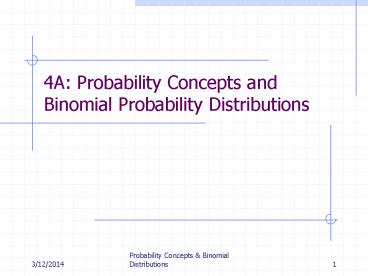4A: Probability Concepts and Binomial Probability Distributions - PowerPoint PPT Presentation
Title:
4A: Probability Concepts and Binomial Probability Distributions
Description:
X random number of successes, which varies 0, 1, 2, 3, or 4 depending on ... I hypothesize p = 0.75, but observe only 2 successes. Should I doubt my hypothesis? ... – PowerPoint PPT presentation
Number of Views:39
Avg rating:3.0/5.0
Title: 4A: Probability Concepts and Binomial Probability Distributions
1
4A Probability Concepts and Binomial Probability
Distributions
2
Definitions
- Random variable ? a numerical quantity that takes
on different values depending on chance - Population ? the set of all possible values for a
random variable - Event ? an outcome or set of outcomes for a
random variable - Probability ? the proportion of times an event
occurs in the population (long-run) expected
proportion
3
Probability (Definition 1)
Probability is its relative frequency of the
event in the population.
Example Let A ? selecting a female at random
from an HIV population There are 600 people in
the population. There are 159 females. Therefore,
Pr(A) 159 600 0.265
4
Probability (Definition 2)
Probability is the long run proportion when the
process in repeated again and again under the
same conditions.
- Select 100 individuals at random
- 24 are female
- Pr(A) ? 24 100 0.24
- This is only an estimate (unless n is very very
big)
5
Probability (Definition 3)
Probability is a quantifiable level of belief
between 0 and 1
Probability Verbal expression
0.00 Never
0.05 Seldom
0.20 Infrequent
0.50 As often as not
0.80 Very frequent
0.95 Highly likely
1.00 Always
Example I believe a quarter of population is
male. Therefore, in selecting individuals at
random Pr(male) 0.25
6
Rules for Probabilities
7
Types of Random Variables
- Discrete have a finite set of possible outcomes,
- e.g. number of females in a sample of size n (0,
1, 2, , n) - We cover binomial random variables
- Continuous have a continuum of possible outcomes
- e.g., average body weight (lbs) in a sample (160,
160.5, 160.75, 160.825, ) - We cover Normal random variables
There are other random variable families, but
only binomial (this lecture) and Normal (next
lecture) families will be covered.
8
Binomial random variables
- Most popular type of discrete random variable
- Bernoulli trial ? random event characterized by
success or failure - Examples
- Coin flip (heads or tails)
- Survival (yes or no)
9
Binomial random variables (cont.)
- Binomial random variable ? random number of
successes in n independent Bernoulli trials - A family of distributions identified by two
parameters - n ? number of trials
- p ? probability of success for each trial
- Notation Xb(n,p)
- X ? random variable
- ? distributed as
- b(n, p) ? binomial RV with parameters n and p
10
Four patients example
- A treatment is successful 75 of time
- We treat 4 patients
- X ? random number of successes, which varies ? 0,
1, 2, 3, or 4 depending on binomial distribution
Xb(4, 0.75)
11
The Binomial Formula
Where nCi the binomial coefficient (next
slide) p probability of success for each
trial q probability of failure 1 p
12
Binomial Coefficient (Choose Function)
where ! ? the factorial function x! x ? (x
1) ? (x 2) ? ? 1 Example 4! 4 ? 3 ? 2
? 1 24 By definition 1! 1 and 0! 1 nCi ?
the number of ways to choose i items out of
n Example 4 choose 2
13
The Four Patients Illustrative Example
- n 4 and p 0.75 (so q 1 - 0.75 0.25)
- Question What is probability of 0 successes? ? i
0 - Pr(X 0) nCi pi qni 4C0 0.750
0.2540 1 1 0.0039 0.0039
14
Xb(4,0.75), continued
Pr(X 1) 4C1 0.751 0.2541 4
0.75 0.0156 0.0469
Pr(X 2) 4C2 0.752 0.2542 6
0.5625 0.0625 0.2106
(Do not demonstrate all calculations. Students
should prove to themselves they derive and
interpret these values.)
15
Xb(4, 0.75) continued
Pr(X 3) 4C3 0.753 0.2543 4
0.4219 0.25 0.4219
Pr(X 4) 4C4 0.754 0.2544 1
0.3164 1 0.3164
16
The Probability Mass Function for Xb(4, 0.75)
Probability table for Xb(4,.75)
Probability curve for Xb(4,.75)
Successes Probability
0 0.0039
1 0.0469
2 0.2109
3 0.4210
4 0.3164
17
Area Under The Curve (AUC)
The area under the curve (AUC) probability!
18
Cumulative Probability (left tail)
- Cumulative probability Pr(X ? i) probability
less than or equal to i - Illustrative example Xb(4, .75)
- Pr(X ? 0) Pr(X 0) .0039
- Pr(X ? 1) Pr(X ? 0) Pr(X 1) .0039 .0469
0.0508 - Pr(X ? 2) Pr(X ? 1) Pr(X 2) .0508 .2109
0.2617 - Pr(X ? 3) Pr(X ? 2) Pr(X 3) .2617 .4219
0.6836 - Pr(X ? 4) Pr(X ? 3) Pr(X 4) .6836 .3164
1.0000
19
The Cumulative Mass Function for Xb(4, 0.75)
Probability function Cumulative probability
Pr(X ? 0) 0.0039 0.0039
Pr(X ? 1) 0.0469 0.0508
Pr(X ? 2) 0.2109 0.2617
Pr(X ? 3) 0.4210 0.6836
Pr(X ? 4) 0.3164 1.0000
20
Cumulative Probability
Area under left tail cumulative probability
Area under shaded bars in left tail sums to
0.2617Pr(X ? 2) 0.2617 Area under curve
probability
21
Reasoning with Probabilities
We use probability model to reasoning about
uncertainty chance.
I hypothesize p 0.75, but observe only 2
successes. Should I doubt my hypothesis? ANS
No. When p 0.75, youll see 2 or fewer
successes 25 of the time (not that unusual).
22
StaTable Probability Calculator
- Three versions
- Java (browser)
- Windows
- Palm
- Calculates probabilities for many pmfs and pdfs
- Example (right) is for a Xb(4,0.75) when x 2
No of successes x
Pr(X x)
Pr(X x)































